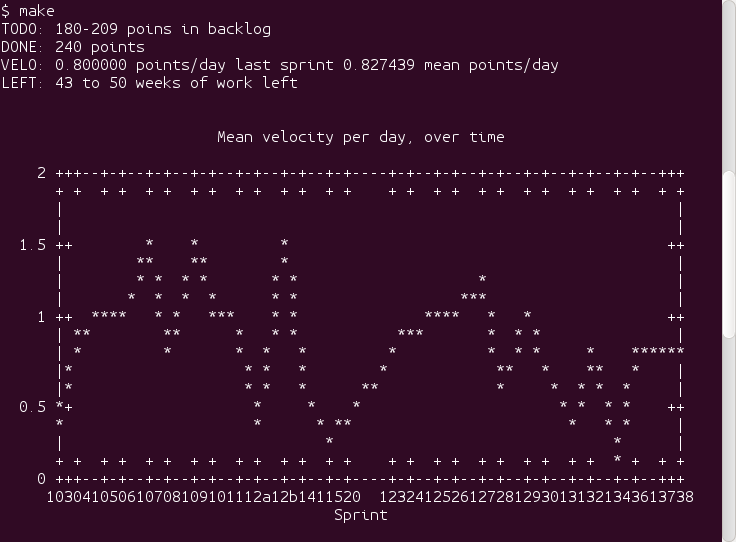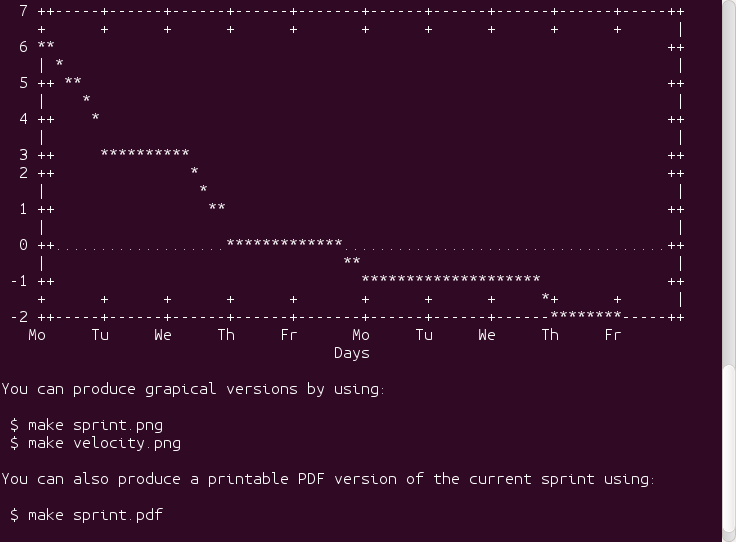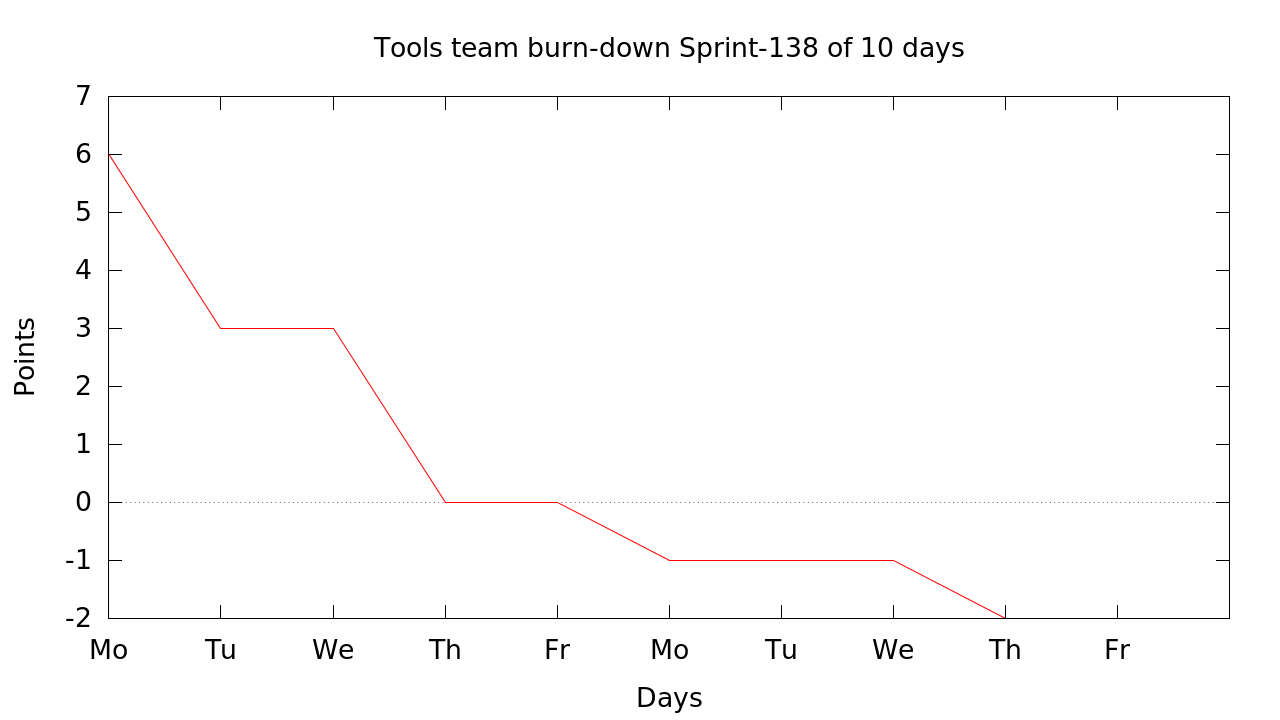Emacs Org-Mode text-file Scrum backlog tools. This project will provide a few simple and quick tools to summarize backlog points, done points, and manage team velocity.
First of all, check the examples-folder for a good view on what your backlog could look like. There is a Makefile there to produce all the artifacts needed for valocity calculation, sprint-burn-down and prognosis of work left in the project, along with ways to make printable story cards for your sprint backlog.
From console with a nicely crafted Makefile or wrapper, you can do this:
And this:
Or if you want to publish the same result as images:
This set of tools came into existence because of the super easy-to-use
Emacs Org-Mode format for keeping track of task-lists. If you want to study
the Org-Mode in further detail than what this README describes please check
out the http://orgmode.org/ page. The bltools might break some of the standard
but if you use this carefully you will be a happy camper, using Emacs (or
other text editors) to keep your backlog in nice shape. It's super convenient
to move thins about in priority order and getting a structured format for
your backlog, without relying on a heavy "agile tool" that requires a
shit-load of administration. The bltools is an attempt to KISS principle.
The text-format is also extremely easy to keep in git. You can resolve conflicts and collaborate very easily this way. I know many teams that keep the backlog in an Excel sheet in the Share-point server or on a shared network folder. But we all know how this will work with multiple users.... Not at all.
It is also very nice to be able to work in text-mode only consoles with your backlog if you're a nerd like me.
Current state of this project is that the parser code and common code is in pretty OK shape, but the executable tools are still in need of improvements. Especially when it comes to documentation. In this README you can _briefly_ get an idea on how to use them. But since the project is pretty young you might still need to refer to the source code to understand how to use the tools in the best way.
You can find excessive check-code for the common code and the parser code in the test-folder. This is also a nice example hon how to use the Tarsio check framework, which can be found here https://github.com/aiobofh/tarsio .
If you run a Scrum team you might have a huge backlog to take care of, this is an example on how to organize your Emacs Org-Mode files:
- backlog.org This is the file where you have all your upcoming tasks stored, in estimated and prioritized fashion.
- sprint.org This is the contents of the current sprint, where you update stories as they get done.
- done.org The graveyard of all done stories.
But you can also keep everything in one file. The bltools usually take only a concatinated file from all .org-files you treat as your backlog as argument.
This is an example of a few valid story slogan rows:
* TODO 00 It shall be possible to store stories in Emacs Org-Mode format As a software developer I need my stories in a very easy to use format, like Emacs Org-Mode to make my agile mindset easier to realize. * TODO 01-20 It shall be possible to make fuzzy estimate ranges of a story As a product owner I want to be able to keep stories estimated even if they are not well defined yet. * TODO 03 It shall be possible to have accurate estimates of a story As a product owner I need to be able to have single (and accurate) estimates of stories in the backlog as the stories grow more defined. * DONE 05 It shall be possible to toggle stories to DONE to track progress SCHEDULED: <2017-01-03> DEADLINE: <2017-01-05> As a product owner I need to be able to track story progress and to be able to calculate velocity over time. * The SCHEDULED Emacs Org-Mode tag is the date when the story was started. * The DEADLINE Emacs Org-Mode tag is the date when the story was done. This is actually MANDATORY to be able to consider a story to be done.
There is a corner case with bltools that requires you to have ALL stories
estimated. But it can handle estimate ranges like this 03-12 meaning that
the story is somewhere between 3p and 12p hard to do. Or you can just put
00 on un-estimated stories until you have had the chance to groom your
backlog further.
Me (personally) prefer to write my stories like this:
* TODO 00 Doc. of bltools shall explain how to write stories :need-estimate:
As a Certified Scrum Master or Certified Product Owner i need to be able
to understand how to keep my backlog in as good a shape as possible to
be able to impress all my friends at work and have them awe my skills.
* [ ] Write some kind of example-based documentation
* [ ] Make sure there are as few spelling errors as possible
* [ ] Try it out on my friends
DoD: The bltools documentation shall explain how to write stories in a
good, example-based way with as few spelling errors as possible.
... Then when the story is groomed and understood by the implementation team the title row should look like this instead (with an estimate):
* TODO 01 Doc. of bltools shall explain how to write stories...
It should also be SHIFT-Up/Down positioned in the correct priority with all the other stories in the backlog Org-Mode file.
When the story is done it should look like this:
* DONE 01 Doc. of bltools shall explain how to write stories
STARTDATE: <2017-03-23> DEADLINE: <2017-03-24>
As a Certified Scrum Master or Certified Product Owner i need to be able
to understand how to keep my backlog in as good a shape as possible to
be able to impress all my friends at work and have them awe my skills.
* [X] Write some kind of example-based documentation
* [X] Make sure there are as few spelling errors as possible
* [X] Try it out on my friends
DoD: The bltools documentation shall explain how to write stories in a
good, example-based way with as few spelling errors as possible.
As simple as that... :) The bltools only care about the TODO/DONE row and
the STARTDATE/DEADLINE-row to build all the information for you, regarding the
burn-down data and velocity calculations.
By just letting the bltools parse this file you can get a lot of information:
$ blsum -d example.org # Get all DONE points 5 $ blsum -t -n example.org # Get a sum of the minimum number of points TODO 4 $ blsum -t -x example.org # Get a sum of the maximum number of points TODO 23
There is also a tool called blcheck which only validates the formatting
of the org-files. So that they look as bltools expect them to look.
It's possible to feed some more information into the blburn command to
get a plotable burn-down for a specific sprint. This requires you to declare
the sprint start/stop, weekdays within the sprint and the commitment.
For example a one-week sprint in the beginning of 2017 with a commitment of 10 points should look something like this:
2017-01-02 2017-01-06 MoTuWeThFr 10 Sprint-001
Stored in a file. What this means is that a sprint is defined between the two days and all the days (Mo, Tu, We, Th and Fr) are working days. The commitment level for the sprint is 10 points and it's called "Sprint-001".
Then the blburn command will be able to generate a series of points for use
with for example GNU Plot to create a burn-down chart plot for the specified
sprint:
$ blburn example.org sprints.list Sprint-001 # Get the burn-down of sprint Mo 10 Tu 10 We 10 Th 5 Fr 5
But if there for example is a holiday on Thursday it shall be removed from the sprint definition line in the sprint-list:
2017-01-02 2017-01-06 MoTuWeFr 10 Sprint-001
And the output will be adjusted accordingly:
$ blburn example.org sprints.list Sprint-001 Mo 10 Tu 10 We 10 Fr 5
Having the sprint-list file defined and the Emacs Org-Mode files in place with the STARTDATE and DEADLINE tags set on DONE stories it's perfectly possible to generate a plot of the velocity trend for your team:
$ blvelocity example.org sprints.list Sprint-001 0.300000 0.300000 Sprint-002 0.900000 0.600000 Sprint-003 1.100000 0.766667 ...
The sprint ID read from the sprint-list file, and the DEADLINE date is used to determine which sprint a story was done and the first floating point number is the mean velocity of the sprint in question, in points per day. The third and last column is the mean velocity over time in points per day. This will help you keep track of over-/under-commitment for future sprints.
It's pretty easy to parse the output from the bltools further to find min/max and graph lengths and such things. A nice way to present them is with Gnuplot.
For example if you'd like a ASCII-art graph in your terminal or a SVG file for your web-site to radiate your progress.
If you use a template somewhat looking like this:
set title "The awesome team burn-down @SPRINTID@ of @DAYS@ days set xlabel "Days" set ylabel "Points" set xzeroaxis set term dumb set nokey set yrange[@MINPTS@:@MAXPTS@] plot [0:@DAYS@] "sprint.dat" using 2:xtic(1) with lines
... You will get a nice burn-down chart for the data from blburn stored in
the sprint.dat file. You need to sed the @KEYWORD@ stuff in this
template to your relevant information.
You can extract the latest sprint ID from your sprint-list using:
$ SPRINTID = $(blsprints sprint.list | tail -1)
You can get the number of days in the sprint by doing some magic like:
$ DAYS = echo "$(tail -1 sprint.list | cut -d' ' -f3 | wc -c)/2" | bc
The magic of having 0 (or less if you managed to finish some Next-storries) as minimum value of the chart:
$ MIN = $(blburn foo.org sprint.list $SPRINTID | tail -1 | cut -d' ' -f2)
$ MINPTS = $(if [ ${MIN} -lt 0 ]; then echo ${MIN}; else echo 0; fi)
... And the commitment for the sprint should probably be the max value:
$ MAXPTS = $(blburn foo.org sprint.list $SPRINTID | head -1 | cut -d' ' -f2)
You can use the output from blvelocity straight away with Gnuplot as well:
set title "Mean velocity per day, over time set xlabel "Sprint" set ylabel "Points" set xzeroaxis set term dumb set nokey set yrange[0:2] plot "velocity.dat" using 2:xtic(1) with lines
This Gnuplot configuration will read the output of blvelocity stored in
the velocity.dat file to generate a nice trend chart.
Most of the executable tools build with this toolkit are still very experimental. However the code library underneath is fairly well checked using Tarsio https://github.com/aiobofh/tarsio .



